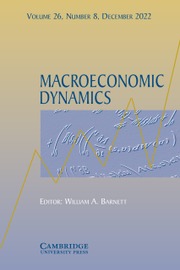Article contents
Human capital-based growth with depopulation and class-size effects: theory and empirics
Published online by Cambridge University Press: 31 March 2025
Abstract
Building on Lucas (1988) and Boucekkine et al. (2013), we develop a model in which the impact of population dynamics on per capita GDP and human capital depends on the balance of intertemporal altruism effects toward future generations and class-size effects on an individual’s education investment. We show that there is a critical level of the class-size effects that determines whether a decline in population growth will lead to a decrease or an increase in a country’s long-run growth rate of real per capita income. We take the model to OECD data, using a semi-parametric technique. This allows us to classify countries into groups based on their long-term growth trajectories, revealing patterns not captured by previous studies on the topic.
Information
- Type
- Articles
- Information
- Copyright
- © The Author(s), 2025. Published by Cambridge University Press
Footnotes
Article last updated 07/04/2025.
References
A correction has been issued for this article:
- 1
- Cited by
Linked content
Please note a has been issued for this article.

